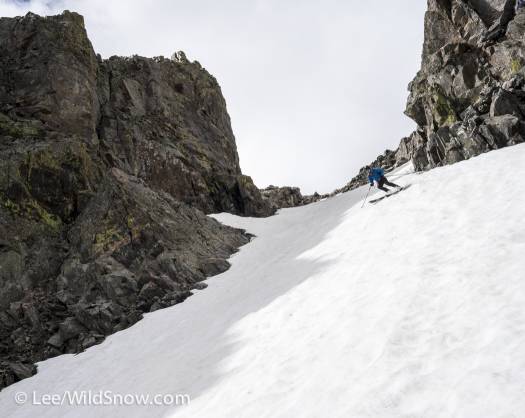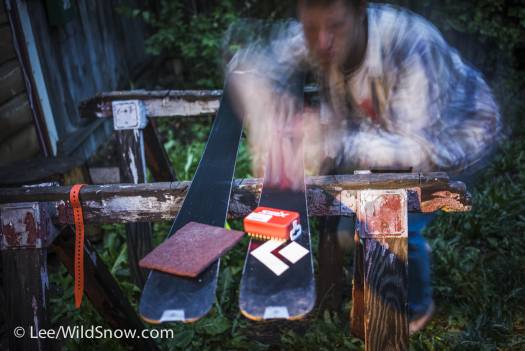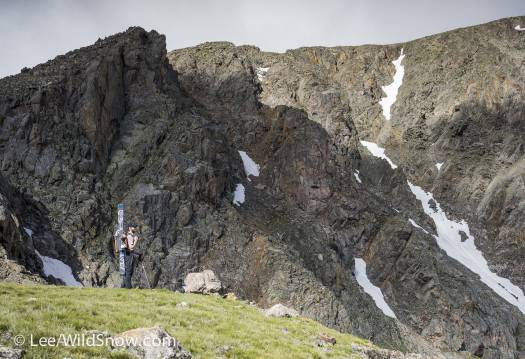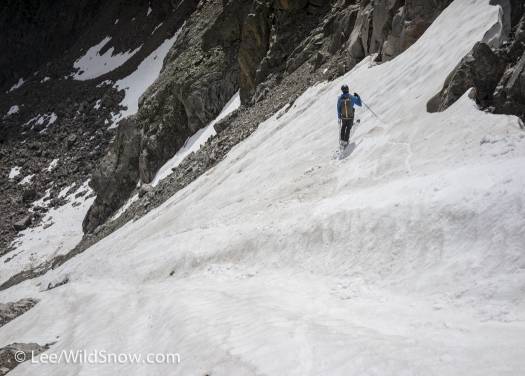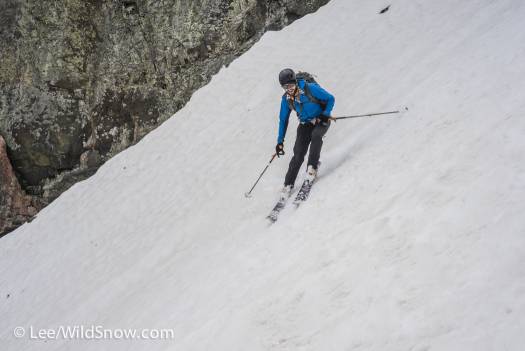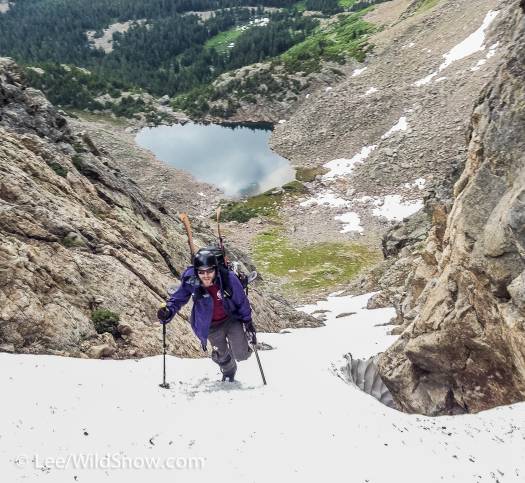What could be more ridiculous than a ski report in late July?! Okay, here goes…
Mount of the Holy Cross sits picturesque above Eagle Valley, a paragon of the Colorado 14er. Visible from Vail ski resort, namesake Cross Couloir (along with well known Angelica Couloir) is the ski mountaineering prize of Holy Cross. However, stretching south from there and once a national monument, the Holy Cross Wilderness holds many wonders of the Northern Sawatch. This range, shorter and sharper than typical in the Sawatch, stretches from Holy Cross to Mount Massive. Couloir skiing at its finest.
Whenever my alarm clock goes off before 5am it seems to do so with a grin. July 19th the bells rang gleefully at 4 and I was out the door, skis in hand. I picked up Tom Judge and drove out Turquoise Lake Road in Leadville, Colorado to the base of Galena Mountain.
I was a bit surprised the day before when Tom didn’t think I was crazy for suggesting a ski, so up we went.
I’ll get back to that silliness in a minute, but first, my hopes for Galena were inflated by a superb day of skiing a week back with my friend Nick Vincent. Vince and I headed up Notch Mountain, the southerly neighbor to Mount of the Holy Cross.
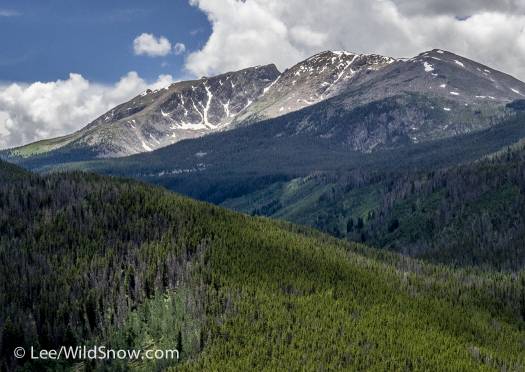
Driving towards Tennessee Pass from Minturn, Colorado there are no views of Holy Cross. Instead, Notch Mountain, rising to 13,237ft, impresses upon the valley. Our line was the obvious shot off of the left shoulder.
Notch Couloir for which the mountain is known, splits the northeast face offering a popular ski mountaineering objective in the area. This melted out back in June. However the Northeast Couloir, a narrow inset cleft on the mountain’s shoulder, was in shockingly fine shape.
A couple hours up the trail, we dropped over the shoulder of Notch and found ourselves skiing down the mountain, ear-to-ear grins all the way.
So, after such unexpected success, I figured the storage wax could wait.
Galena stands guard over the head of the Arkansas River Valley at only 12,893ft, relatively short given its neighborhood. Nonetheless this proud peak maintains a sufficient degree of grandeur, rising steeply from the valley below in an uncharacteristically craggy fashion.
This is the southern end of the Holy Cross Wilderness. A view known well to anyone who has visited Uncle Bud’s Hut; the east face of Galena houses several steep couloirs strikingly visible from Colorado Highway 24 as well.
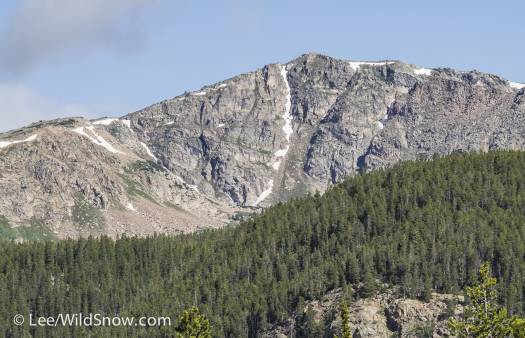
The most commanding line splits the face from near the peak’s summit down to St. Kevin’s Lake. It is known as Rabbit Ears Couloir (along with a second branch, the couloir forms the shape of a rabbit’s ears).
Because of its prominence above the valley, Rabbit Ears Couloir makes for what I like to call a ‘town line.’ Sitting in Leadville drinking coffee, eating pizza, or admiring the high peaks’ sunset, this line immediately catches one’s eye; it has been on my list for some time, and though Galena looks quite dry these days, a squiggle of silliness remains.
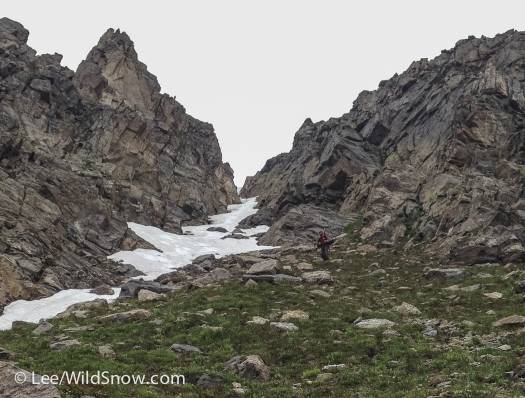
The line is southeast facing, so by all accounts it should have melted out months ago. Somehow it has held a diminutive grip on the inset, narrow, upper section of the route.
The hike into St. Kevin’s was a beautiful meander up an unmarked trail to an all-but-forgotten alpine lake that only took an hour from the summer trailhead. Another hour and a half and we were on top of Galena.
I was increasingly skeptical of the descent the higher we got.
I generally assume that any line of snow I can spy from a good distance grows with proximity. Rabbit Ears did not. In fact it seemed to shrink the closer we got.
The upper pinch in the line held plenty of snow, as was made very visible from the 20+ ft deep melt crack bordering one edge of the couloir. The problem was not in depth, but in width. I was on a pair of 176cm Black Diamond Carbon Aspects, and at its narrowest point I would say the couloir was 175cm wide at best. This made for a very scary bit of skiing.
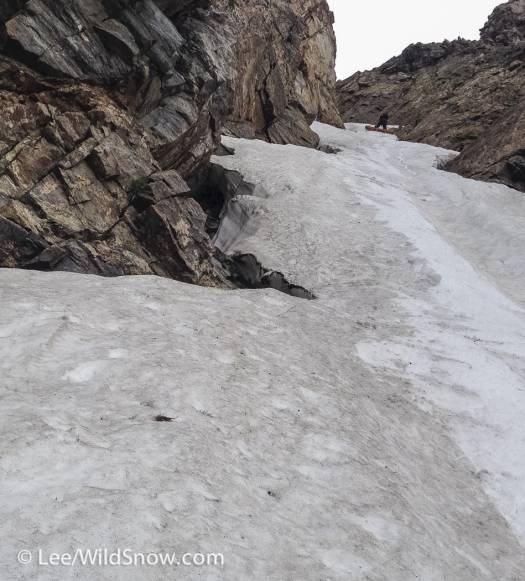
Ice axe in hand I slid, managing only to make the occasional jump turn down the narrows of Rabbit Ears. How Tom managed to slide through on a split board, I don’t know.
The line itself was super cool, with epic views of Leadville and the upper Ark, though after wiggling down the 400 or so vert that still held snow, I would not say the line was ‘in’.
Tom and I decided the day’s adventure was the best type of bad idea.
Skiing, like most recreational activities, is a useless pursuit. But, therein lies its beauty. To slide down mountains with boards strapped to our feet is freedom, fun, and fantastical. Why restrict such silliness to ‘ski season’?
I figure winter is primarily a state of mind, so might as well keep those edges sharp and glisse on.
(WildSnow.com Guest Blogger Alex Lee lives in Leadville, Colorado in the winter and Denali, Alaska in the summer. He is currently working towards a Ph.D. in the ethics of conservation at the University of Colorado. He works part-time as a naturalist in Alaska and as a ski guide and photographer in the Colorado Rockies. Like his pictures? Check out more at his website, MountainDinosaur.com.)
Dr. Alex Lee lives in Anchorage, Alaska. Alex is a professor at Alaska Pacific University, teaching philosophy and environmental studies. He also works as a sometimes guide, naturalist, writer, and photographer.

